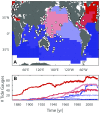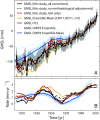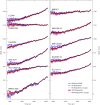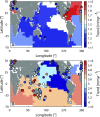Reassessment of 20th century global mean sea level rise
- PMID: 28533403
- PMCID: PMC5468634
- DOI: 10.1073/pnas.1616007114
Reassessment of 20th century global mean sea level rise
Abstract
The rate at which global mean sea level (GMSL) rose during the 20th century is uncertain, with little consensus between various reconstructions that indicate rates of rise ranging from 1.3 to 2 mm⋅y-1 Here we present a 20th-century GMSL reconstruction computed using an area-weighting technique for averaging tide gauge records that both incorporates up-to-date observations of vertical land motion (VLM) and corrections for local geoid changes resulting from ice melting and terrestrial freshwater storage and allows for the identification of possible differences compared with earlier attempts. Our reconstructed GMSL trend of 1.1 ± 0.3 mm⋅y-1 (1σ) before 1990 falls below previous estimates, whereas our estimate of 3.1 ± 1.4 mm⋅y-1 from 1993 to 2012 is consistent with independent estimates from satellite altimetry, leading to overall acceleration larger than previously suggested. This feature is geographically dominated by the Indian Ocean-Southern Pacific region, marking a transition from lower-than-average rates before 1990 toward unprecedented high rates in recent decades. We demonstrate that VLM corrections, area weighting, and our use of a common reference datum for tide gauges may explain the lower rates compared with earlier GMSL estimates in approximately equal proportion. The trends and multidecadal variability of our GMSL curve also compare well to the sum of individual contributions obtained from historical outputs of the Coupled Model Intercomparison Project Phase 5. This, in turn, increases our confidence in process-based projections presented in the Fifth Assessment Report of the Intergovernmental Panel on Climate Change.
Keywords: climate change; fingerprints; global mean sea level; tide gauges; vertical land motion.
Conflict of interest statement
The authors declare no conflict of interest.
Figures












References
-
- Church JA, White NJ. Sea-level rise from the late 19th to the early 21st Century. Surv Geophys. 2011;32:585–602.
-
- Ray RD, Douglas BC. Experiments in reconstructing twentieth-century sea levels. Prog Oceanogr. 2011;91:496–515.
-
- Wenzel M, Schroeter J. Reconstruction of regional mean sea level anomalies from tide gauges using neural networks. J Geophys Res. 2010;115:C08013.
-
- Calafat FM, Chambers DP, Tsimplis MN. On the ability of global sea level reconstructions to determine trends and variability. J Geophys Res. 2014;119:1572–1592.
-
- Jevrejeva S, Moore JC, Grinsted A, Matthews AP, Spada G. Trends and acceleration in global and regional sea levels since 1807. Global Planet Change. 2014;113:11–22.
Publication types
LinkOut - more resources
Full Text Sources
Other Literature Sources

